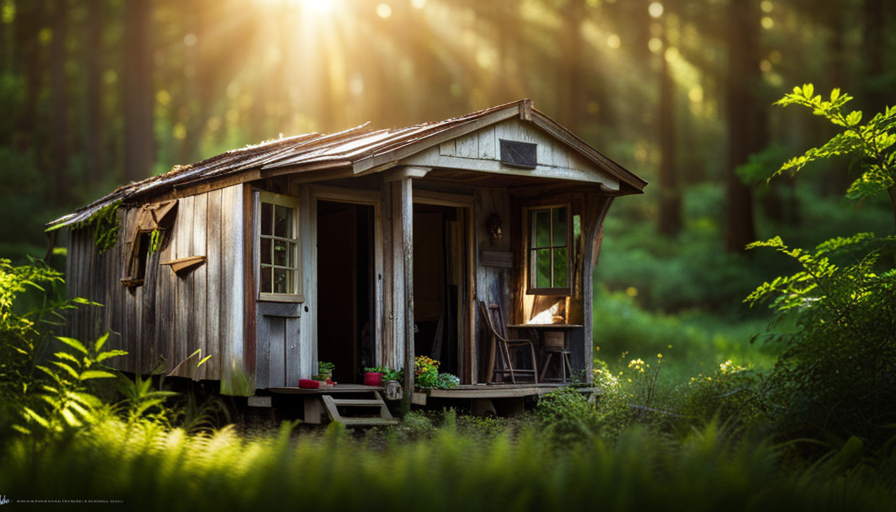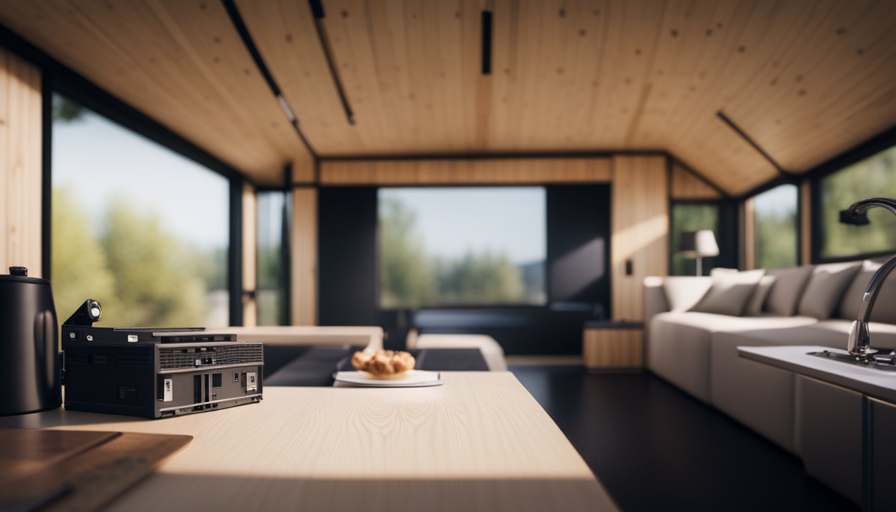Did you know that a tiny home can run completely on solar energy? By installing a sufficient amount of solar panels, you can enjoy all the comforts of home while reducing your environmental footprint.
But how many 45W solar panels do you actually need to power a tiny house? Let’s dive into the data and find out.
Assessing your energy needs is the first step in determining the number of solar panels required. Factors such as location and sunlight availability also play a crucial role. Additionally, considering the efficiency and energy output of each 45W solar panel is essential.
By calculating your tiny house’s energy consumption and dividing it by the energy output of a single 45W solar panel, you can estimate how many panels are needed. Remember to round up to the nearest whole number for an accurate count.
Adding extra panels for redundancy and future expansion is always recommended. For professional advice and installation guidance, consult with a solar energy expert.
So, let’s harness the power of the sun and make our tiny houses truly sustainable!
Key Takeaways
- Tiny houses can be powered entirely by solar energy.
- The number of 45W solar panels needed depends on energy consumption and panel efficiency.
- It is recommended to round up to the nearest whole number when calculating the number of panels needed.
- Adding extra panels for redundancy and future expansion is recommended.
Assess Your Energy Needs
You’ll need to take a moment and assess just how much energy your tiny house requires before determining the number of 45w solar panels you’ll need.
This is an important step as it will help you understand if the 45w solar panels are sufficient for your energy needs.
To start, consider the efficiency of the solar panels you plan to use. The efficiency determines how much power can be generated from a given amount of sunlight. Higher efficiency means more power generation.
Next, estimate your energy consumption by considering all the appliances and devices that will be powered by the solar panels. Calculate their wattage and multiply it by the number of hours they are expected to run each day. This will give you an estimate of your daily energy consumption.
Once you have this information, divide your daily energy consumption by the wattage rating of the 45w solar panel to determine how many panels you’ll need. Keep in mind that this calculation assumes optimal conditions and doesn’t account for factors like cloudy days or shading.
Considering your location and sunlight availability is crucial in determining if 45w solar panels alone can meet your energy needs effectively.
Consider Your Location and Sunlight Availability
Take into account where you live and how much sunlight you can count on. When considering the number of 45W solar panels needed to power a tiny house, it’s crucial to evaluate your geographical location and the amount of sunlight available. Here are three key factors to consider:
-
Solar panel efficiency: The efficiency of solar panels varies depending on the brand and technology used. Higher efficiency panels can generate more electricity from the same amount of sunlight compared to lower efficiency ones. It’s essential to choose solar panels with higher efficiency ratings to maximize energy production within limited space.
-
Geographical location: Different regions receive varying amounts of sunlight throughout the year due to differences in latitude, climate, and weather patterns. Areas closer to the equator generally have more consistent and intense sunlight, enabling solar panels to produce more electricity. On the other hand, locations with frequent cloud cover or long winters may experience reduced solar generation.
-
Sunlight availability: Assessing how much direct sunlight your property receives each day is vital for determining the number of solar panels required. Factors such as shading from nearby buildings or trees can impact sunlight availability and affect panel performance.
Considering these aspects will help you determine the efficiency of the solar panels needed for your tiny house project seamlessly.
Next, let’s delve into how to assess the efficiency of these solar panels without compromising their effectiveness in powering your tiny house effectively.
Determine the Efficiency of the Solar Panels
To gauge the efficiency of the solar panels for your tiny house, it’s crucial to assess how effectively they convert sunlight into electricity. Solar panel efficiency refers to the ability of the panels to convert sunlight into usable energy. This is an important factor to consider when determining how many 45W solar panels you’ll need.
When comparing different solar panel efficiencies, you should look at their conversion rates. The higher the efficiency percentage, the more electricity a panel can generate from a given amount of sunlight. For example, if one panel has an efficiency of 20% and another has an efficiency of 15%, the first panel will produce more electricity than the second one.
Calculating solar panel efficiency involves dividing the output power by the input power and multiplying it by 100%. This calculation will give you a percentage that represents how efficient a particular solar panel is in converting sunlight into electricity.
By comparing different solar panel efficiencies, you can determine which panels are most suitable for your tiny house setup. Once you’ve assessed this aspect, you can move on to calculating the energy output of a 45W solar panel without compromising its performance or capacity.
Calculate the Energy Output of a 45W Solar Panel
Once you’ve determined the efficiency of your solar panels, it’s time to dive into calculating just how much energy a 45W panel can produce. To calculate solar panel efficiency, you need to know the amount of sunlight that hits the panel and how much of that is converted into electricity.
The energy output of a solar panel is measured in kilowatt-hours (kWh) per day.
To calculate the energy output of a 45W solar panel, you first need to consider its efficiency rating. Let’s say the efficiency rating is 20%. This means that for every hour of direct sunlight, the panel will generate 9 watt-hours (0.045 x 20) of electricity. Multiply this by the number of hours in a day when there is direct sunlight to get the total daily energy output.
Now, let’s compare the energy output of different wattage solar panels. For example, if we have a 100W solar panel with the same efficiency rating, it would generate 20 watt-hours per hour or 200 watt-hours per day.
Once you know the efficiency and wattage of your solar panels, you can easily calculate their energy output per day. Now that we understand how much energy a single panel can produce, let’s estimate your tiny house’s energy consumption without writing ‘step’.
Estimate Your Tiny House’s Energy Consumption
Imagine living in a cozy little home and envision the amount of energy your tiny house consumes. As someone who’s passionate about sustainable living, I understand the importance of reducing energy consumption in a tiny house. Here are some tips to help you achieve that goal.
Firstly, consider using energy-efficient appliances and lighting fixtures. LED bulbs, for example, consume significantly less energy compared to traditional incandescent bulbs. Additionally, opt for appliances with high Energy Star ratings to ensure they operate efficiently.
Another way to reduce energy consumption is by insulating your tiny house properly. By improving insulation, you can minimize heat loss during winter and prevent excessive heat gain during summer. This will help maintain a comfortable indoor temperature without relying heavily on heating or cooling systems.
Now let’s talk about solar panel options for powering your tiny house. When comparing different solar panels, it’s important to consider their cost-effectiveness in relation to your energy needs. While 45W solar panels may be suitable for some households, others might require larger capacity panels or multiple units.
Implementing energy-saving measures like using efficient appliances and improving insulation can significantly reduce the amount of energy your tiny house consumes. When considering solar panel options, take into account the specific needs of your household to determine how many panels are necessary.
Transition: Now that we have explored ways to reduce energy consumption in a tiny house, let’s move on to calculating the total energy output needed for powering your home efficiently without any wastage.
Calculate the Total Energy Output Needed
Get ready to calculate the total energy output you’ll need to power your cozy little home efficiently and enjoy sustainable living! To determine the total energy output needed for your tiny house, you first need to calculate your energy usage. Consider all the appliances and devices you plan on using, their power consumption in watts, and the average number of hours they will be used per day. This will give you an estimate of your daily energy consumption.
Once you have calculated your daily energy usage, it’s time to choose the appropriate solar panels. Solar panels come in different wattage capacities, so you’ll want to find ones that can meet or exceed your daily energy needs.
To help visualize this process, refer to the table below:
| Appliance/Device | Power Consumption (W) | Average Daily Usage (hours) |
|---|---|---|
| Lights | 50 | 4 |
| Refrigerator | 100 | 24 |
| Laptop | 30 | 6 |
| TV | 70 | 3 |
| Fan | 75 | 8 |
By calculating the total watt-hours consumed by each appliance and summing them up, you can determine the total daily energy output required for your tiny house. Once you have this value, we can move on to dividing it by the energy output of a standard 45w solar panel.
Now that we have determined our total daily energy requirements let’s move on to dividing this value by the energy output of a single 45w solar panel.
Divide the Total Energy Output by the Energy Output of a 45W Solar Panel
Now that we’ve calculated the total energy output needed to power a tiny house, let’s move on to the next step: dividing this total energy output by the energy output of a 45W solar panel.
By doing this calculation, we can determine how many 45W solar panels are required for our tiny house.
To calculate the energy requirements, we need to take into account the daily energy consumption of our appliances and devices. This includes lighting, heating or cooling systems, kitchen appliances, and any other electrical equipment used in the tiny house.
Once we have determined the total energy output needed per day, we can proceed with comparing different solar panel options.
A 45W solar panel has an energy output of 45 watts per hour. To find out how many panels are needed, divide the total energy output needed by the energy output of one panel. This will give us the number of panels required to meet our daily energy needs.
Once we have obtained this value, it’s important to round up to the nearest whole number since we can’t purchase fractional panels. So, make sure to round up your final answer before moving on to the subsequent section about rounding up to the nearest whole number.
Round Up to the Nearest Whole Number
Round up the number of panels required to meet your daily energy needs to the nearest whole number. Estimating solar panel requirements is crucial for ensuring that your tiny house has enough power. To determine the optimal number of 45W solar panels needed, you need to divide your total energy output by the energy output of a single panel. Once you have this figure, round it up to ensure you have sufficient power.
When determining optimal panel placement, consider factors such as sunlight exposure and shading. Maximizing direct sunlight on your panels will increase their efficiency and overall power generation. Additionally, avoid any obstructions like trees or buildings that may cast shadows on the panels during peak sun hours.
After calculating your required number of solar panels based on daily energy needs, consider adding extra panels for redundancy and future expansion. This additional capacity can be helpful in case of unexpected surges in electricity consumption or if you decide to upgrade appliances in the future. It’s always better to have more power available than not enough.
Estimating solar panel requirements involves rounding up the necessary number of 45W solar panels to meet daily energy needs. Determining optimal panel placement ensures maximum sunlight exposure and minimal shading. Moreover, considering additional panels for redundancy and future expansion provides flexibility and peace of mind.
Consider Adding Extra Panels for Redundancy and Future Expansion
Consider adding extra panels to your solar setup for added security and the ability to easily expand your energy capacity in the future. Adding extra panels for redundancy and future expansion is crucial when it comes to powering a tiny house with solar energy.
Not only does it provide an additional layer of backup power, but it also allows you to increase your energy production as needed.
In a tiny house, where space is limited, having backup power is essential. By incorporating extra solar panels into your system, you ensure that even if one panel malfunctions or gets damaged, there are others available to pick up the slack. This redundancy ensures that you won’t be left without electricity during critical times.
Moreover, planning for future expansion is important when considering your solar setup. As your energy needs grow or if you decide to add more appliances or devices to your tiny house, having extra panels will allow you to meet those increased demands without any hassle.
To determine the exact number of panels required for your specific situation, I recommend consulting with a solar energy professional for expert advice and installation. They can assess your energy needs, consider factors such as location and sun exposure, and provide guidance on the optimal number of 45W solar panels needed for your tiny house setup.
Consult with a Solar Energy Professional for Expert Advice and Installation
To make sure you get the best advice and installation for your solar energy needs, it’s worth consulting with a professional in the field. A solar energy professional can provide expert guidance on the number of 45W solar panels required to power your tiny house efficiently. They will assess several factors such as your energy consumption, available roof space, and location to determine the optimal panel configuration.
When considering a solar panel installation for your tiny house, there are several key benefits to keep in mind. Firstly, solar power is a renewable energy source that reduces carbon emissions and contributes to a more sustainable future. Additionally, harnessing solar power can significantly reduce or eliminate your monthly electricity bills, saving you money in the long run.
Consulting with a professional will also help you understand the costs associated with installing solar panels on your tiny house. They can provide accurate estimates based on factors like panel quantity, installation complexity, and any additional equipment needed for efficient operation.
Here is an example of how consulting with a solar energy professional can benefit you:
- They will analyze your current energy usage patterns and recommend an appropriate number of 45W panels.
- They can advise on potential future expansion options should you decide to increase your power requirements.
- By evaluating the average daily sunlight hours in your area, they can estimate the amount of electricity generated by these panels throughout different seasons.
Overall, seeking expert advice from a solar energy professional ensures that you make informed decisions regarding panel quantity and placement while considering both upfront costs and long-term savings.
Frequently Asked Questions
How do I assess my energy needs for a tiny house?
To assess my energy needs for a tiny house, I start by evaluating the appliances and devices I plan to use. It’s important to choose energy-efficient options that consume less power without compromising functionality. By calculating the wattage of each appliance and estimating their daily usage, I can determine my total energy consumption per day.
From there, I can decide how many 45W solar panels are required to meet my energy demands efficiently and sustainably.
What factors should I consider when determining the efficiency of solar panels?
When determining the efficiency of solar panels, several factors and considerations come into play.
The angle and orientation of the panels, shading from trees or buildings, temperature variations, and panel quality all impact their performance.
Additionally, the type and capacity of batteries used for energy storage are crucial.
Monitoring systems can provide real-time data on energy production to help optimize efficiency.
These factors collectively determine how effectively solar panels convert sunlight into usable electricity for your tiny house needs.
How can I estimate the energy consumption of my tiny house?
To estimate energy usage in a tiny house, it’s crucial to consider the efficiency of appliances. Start by identifying all the appliances you plan to use and their power ratings. Add up their power consumption over a day or month, considering how long each appliance is used.
Efficient appliances can significantly reduce energy consumption. Once you have an estimate, you can then determine the number of 45W solar panels needed based on your daily energy needs and panel efficiency.
How do I calculate the total energy output needed for my tiny house?
Calculating energy requirements for a tiny house involves estimating the total energy output needed. To do this, one must consider various factors such as appliances, lighting, and heating/cooling systems. By analyzing their power ratings and daily usage, we can determine the average energy consumption per day.
From there, it’s possible to estimate solar panel capacity required to meet these needs. It’s crucial to ensure that the panels’ combined wattage exceeds the total energy demand of the house.
Why should I consult with a solar energy professional for advice and installation?
Consulting with a solar energy professional for advice and installation is crucial due to the numerous benefits of their expertise.
A consultation provides valuable insights into the specific energy needs of your tiny house, ensuring an accurate calculation of the total energy output required.
Additionally, professional installation ensures that your solar panels are correctly positioned and connected, maximizing their efficiency.
Their technical knowledge and experience guarantee a reliable and durable solar power system for your tiny house.
Conclusion
In conclusion, after assessing my energy needs and considering the location and sunlight availability, I determined that I would need three 45W solar panels to power my tiny house.
By calculating the energy output of a single panel and estimating my house’s energy consumption, I was able to divide the total energy output by the panel’s output.
To add redundancy and allow for future expansion, I might consider adding extra panels. However, it’s always advisable to consult with a solar energy professional for expert advice and installation.
Remember, "The proof is in the pudding!"
Hi, I’m Emma. I’m the Editor in Chief of Tiny House 43, a blog all about tiny houses. While tree houses are often associated with childhood, they can be the perfect adult retreat. They offer a cozy space to relax and unwind, surrounded by nature. And since they’re typically built on stilts or raised platforms, they offer stunning views that traditional homes simply can’t match. If you’re looking for a unique and romantic getaway, a tree house tiny house might just be the perfect option.










